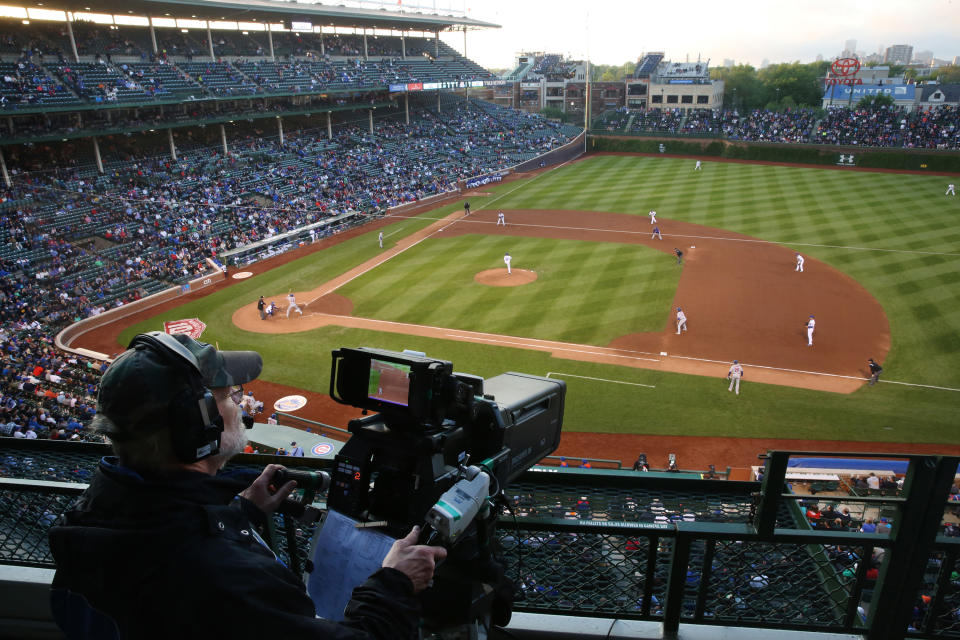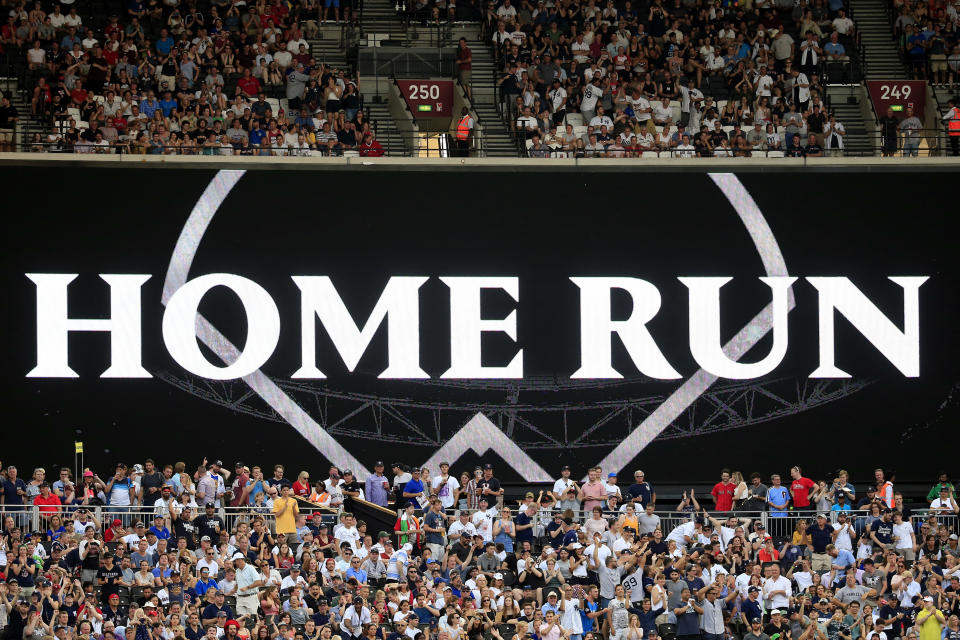How MLB should broadcast games in the future
For 81 years, baseball has been at the forefront of the ever-growing and ever-evolving relationship between sports and television.
The first televised baseball game was on May 17, 1939, when an Ivy League game between Princeton and Columbia aired in New York on what would later become WNBC-TV. Three months later, on Aug. 26, 1939, the Cincinnati Reds and Brooklyn Dodgers were involved in the first Major League Baseball game to be shown on television.
In 1947, the first World Series was broadcasted by NBC. One year later, WGN-TV broadcasted its first baseball game. In 1955, NBC offered a World Series broadcast entirely in color for the very first time. While on July 17, 1959, instant replay was first introduced to baseball broadcasts.
Some 60 years later, the evolution continues. The advancement of technology and the creation of countless networks and streaming platforms has expanded the ways baseball can be consumed.
Now though, with television serving as the sole connection between the game and its fans in 2020 amid the coronavirus pandemic, much focus is being put on what the future of baseball on television will or, perhaps more accurately, should look like as MLB struggles to keep up with the NFL, NBA and major college sports.
How can MLB make baseball a must-see experience that engages a wider audience? There’s no one clear answer, mainly because there are multiple issues that must be addressed. Here, we’ll highlight those issues while looking at possible solutions.
Be more flexible with blackouts
You can’t watch what you can’t see.
For close to two decades, MLB fans have been frustrated by a blackout policy that in some areas — like Iowa and Las Vegas — eliminates six teams from the viewing menu on MLB.TV. The policy gives regional sports networks exclusive rights to broadcast games, but when those networks don’t actually extend into the territory they’ve claimed, those fans are left in the dark.
On one hand, we understand it’s part of the business agreement and we understand why regional networks want exclusive rights over national broadcasts and MLB’s streaming services. But why can’t it be more flexible? Why not make Sundays a blackout free day? Why not unlock and promote more games with big storylines — a top prospect making his MLB debut or a veteran player chasing a milestone.
Giving people more ways to experience moments is how you hook them. It’s how you grow an audience and it will help everybody, even the regional networks.

Make highlights accessible, interactive
Beyond the blackout rules, MLB has also made sharing highlights a difficult task for fans.
Unlike the NFL or NBA, where a shareable highlight on social media exists almost as soon as a buzzy moment itself occurs, baseball fans are often left waiting and wondering what all the tweets were about. And sometimes, the waiting never ends.
MLB must do a better job capturing that buzz before it wears off. Perhaps the best solution is letting the fans do the work.
Whether we’re watching on television, a computer or a mobile streaming device, we’re already able to pause and rewind the action. What if we could pause, rewind and record a moment that amused or fascinated us. Not just gifs, but real clips. Clips that capture more than just the home runs or defensive gems we will eventually see in highlight packages, but capture the essence of our individual fandom.
And then fans should be allowed to share those clips, be it on Twitter or MLB.TV or another outlet that falls under the MLB umbrella. Let fans determine the moments that are worth sharing and reliving with other fans. Let baseball fans create the buzz and help baseball grow.
Enhance the viewer experience
Fans love feeling connected to the players. That is why there’s always a positive reaction when broadcasts include in-game communication between players and broadcasters.
The set up has been mainly used in exhibition games, such as spring training or the All-Star Game. But bringing more insight or more interaction into more games — specifically, games that count — would certainly have appeal.
Getting the players on board is the first step. Based on recent comments, that first step could be a doozy. Many players have expressed opposition to being mic’d up for regular season or postseason games. Understandably so. There’s a certain focus players like to maintain that being prodded by broadcasters would certainly disrupt. But maybe there are ways to work around that, or even give players incentive to get on board.
With the CBA coming up next winter, that could provide an opening to at least discuss the possibilities. Maybe players can be offered extra money to be featured once or twice a season. We don’t have to go crazy with it. Just make it available.
And maybe check out what the NBA has planned for 2020.
Adam Silver underscores that no fans will be allowed at the NBA restart, but to provide a better remote experience, game broadcasts will include increased camera angles,
personalized alternative screens, "enhanced audio" of players & coaches, and virtual concerts & halftimes.— Rachel Nichols (@Rachel__Nichols) June 26, 2020
Invite fans into the action. It breathed new life into the XFL. It can do the same for MLB.
Limit interruptions
One of commissioner Rob Manfred’s main focuses has been improving pace of play.
During his five years in office, rules have changed to accommodate that. Fewer mound visits, less frequent pitching changes and shorter inning breaks are among those already implemented. Yet despite those changes, MLB posted its highest ever nine-inning game time average of three hours, five minutes and 35 seconds in 2019.
It’s the players who ultimately dictate the pace, but there might be a way television can help too. In fact, we’re already seeing how. Over the last three years, we’ve seen networks include more picture-in-picture ads while replays and pitching changes are ongoing. It’s happening in other sports too, and even on widely viewed entertainment programs. And the truth is, it doesn’t take away from the broadcasts. It may even enhance the experience because it allows viewers to remain engaged and invested.
MLB could further apply that strategy by limiting traditional ad breaks between innings. If the networks and sponsors are on board, why not run more picture-in-picture stuff and establish a pace that forces players to adapt and allows fans to remain engaged.

Create a ‘Red Zone’ experience
There are many reasons why the NFL is currently the standard for sports viewing. Among them is its refusal to let fans look away.
Specifically, the creation of NFL Red Zone channel gives fans an outlet to experience the moments that matter or follow their fantasy football teams in real time. The channel exists to serve those purposes and it’s there for seven hours every Sunday afternoon.
MLB does not have that outlet. And the truth is, it’s the sport that might need it the most. Baseball games can be dull. Action is not guaranteed. When forced to focus on one game, there’s not always a hook for casual fans. But with so many games taking place at once, there’s bound to be action, intrigue, or even an opportunity to feature a superstar player.
MLB Network provides this element to some degree. But there is not always a commitment to bring fans the moments as they happen. ‘Red Zone’ works because the top priority is giving the fans live action. As previously mentioned, MLB falls short because most of its big moments appear in “Whoa, did you see that?” tweets. And the answer is always “Nope, sure didn’t.”
With so much daily content, MLB can do a better job of spotlighting the moments people will talk about.
More from Yahoo Sports:

 Yahoo Sports
Yahoo Sports 